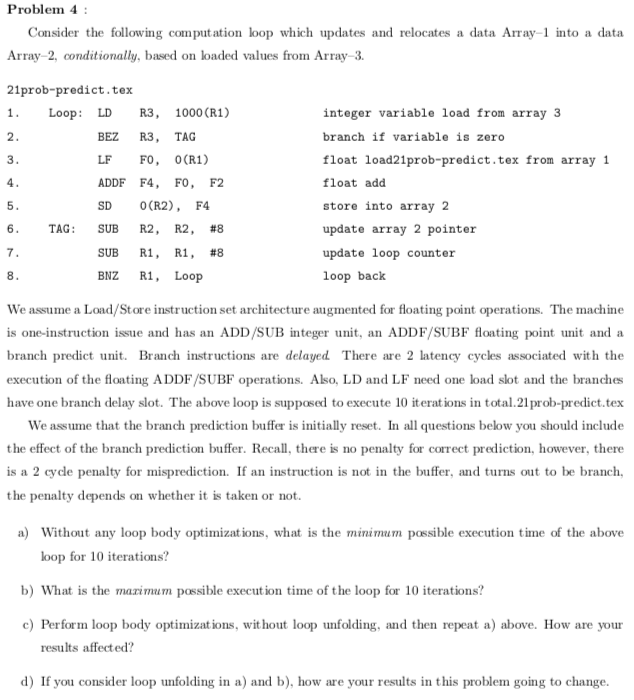
Problem 4 Consider the following computation loop which updates and relocates a data Array-1 into a data Array 2, conditionally, based on loaded values from Array-3. 21prob-predict.tex Loop: LD BEZ R3, TAG LF FO, 0(R1) ADDF F4, FO, F2 SD (R2) F4 R3, 1000 (RI) integer variable load from array 3 branch if variable is zero float load21prob-predict.tex from array 1 float add store into array 2 update array 2 pointer update loop counter loop back 2 3 TAG : SUB R2 , R2 , #8 SUB R1, R1 , #8 BNZ R1 Loop We assume a Load/Store instruction set architecture augmented for floating point operations. The machine is one-instruction issue and has an ADD/SUB integer unit, an ADDF/SUBF floating point unit and a branch predict unit. Branh instructions are delayed There are 2 latency cycles associated with the execution of the floating ADDF/SUBF operations. Also, LD and LF need one load slot and the branches have one branch delay slot. The above loop is supposed to execute 10 iterations in total.21 prob-predict.tex We assume that the branch prediction buffer is initially reset. In aquestions below you should include t he effect of the branch prediction buffer. Recall, there is no penalty for correct prediction, however, there is a 2 cycde penalty for misprediction. If an instruction is not in the buffer, and turns out to be branch, the penalty depends on whether it is taken or not a) Without any loop body optimizations, what is the minimun possible execution time of the above loop for 10 iterations? b) What is the mazimum possible execution time of the loop for 10 iterations? c) Perform loop body optimizations, wit hout loop unfolding, and then repeat a) above. How are your results affected? d) If you consider loop unfolding in a) and b), how are your results in this problem going to change. Problem 4 Consider the following computation loop which updates and relocates a data Array-1 into a data Array 2, conditionally, based on loaded values from Array-3. 21prob-predict.tex Loop: LD BEZ R3, TAG LF FO, 0(R1) ADDF F4, FO, F2 SD (R2) F4 R3, 1000 (RI) integer variable load from array 3 branch if variable is zero float load21prob-predict.tex from array 1 float add store into array 2 update array 2 pointer update loop counter loop back 2 3 TAG : SUB R2 , R2 , #8 SUB R1, R1 , #8 BNZ R1 Loop We assume a Load/Store instruction set architecture augmented for floating point operations. The machine is one-instruction issue and has an ADD/SUB integer unit, an ADDF/SUBF floating point unit and a branch predict unit. Branh instructions are delayed There are 2 latency cycles associated with the execution of the floating ADDF/SUBF operations. Also, LD and LF need one load slot and the branches have one branch delay slot. The above loop is supposed to execute 10 iterations in total.21 prob-predict.tex We assume that the branch prediction buffer is initially reset. In aquestions below you should include t he effect of the branch prediction buffer. Recall, there is no penalty for correct prediction, however, there is a 2 cycde penalty for misprediction. If an instruction is not in the buffer, and turns out to be branch, the penalty depends on whether it is taken or not a) Without any loop body optimizations, what is the minimun possible execution time of the above loop for 10 iterations? b) What is the mazimum possible execution time of the loop for 10 iterations? c) Perform loop body optimizations, wit hout loop unfolding, and then repeat a) above. How are your results affected? d) If you consider loop unfolding in a) and b), how are your results in this problem going to change







